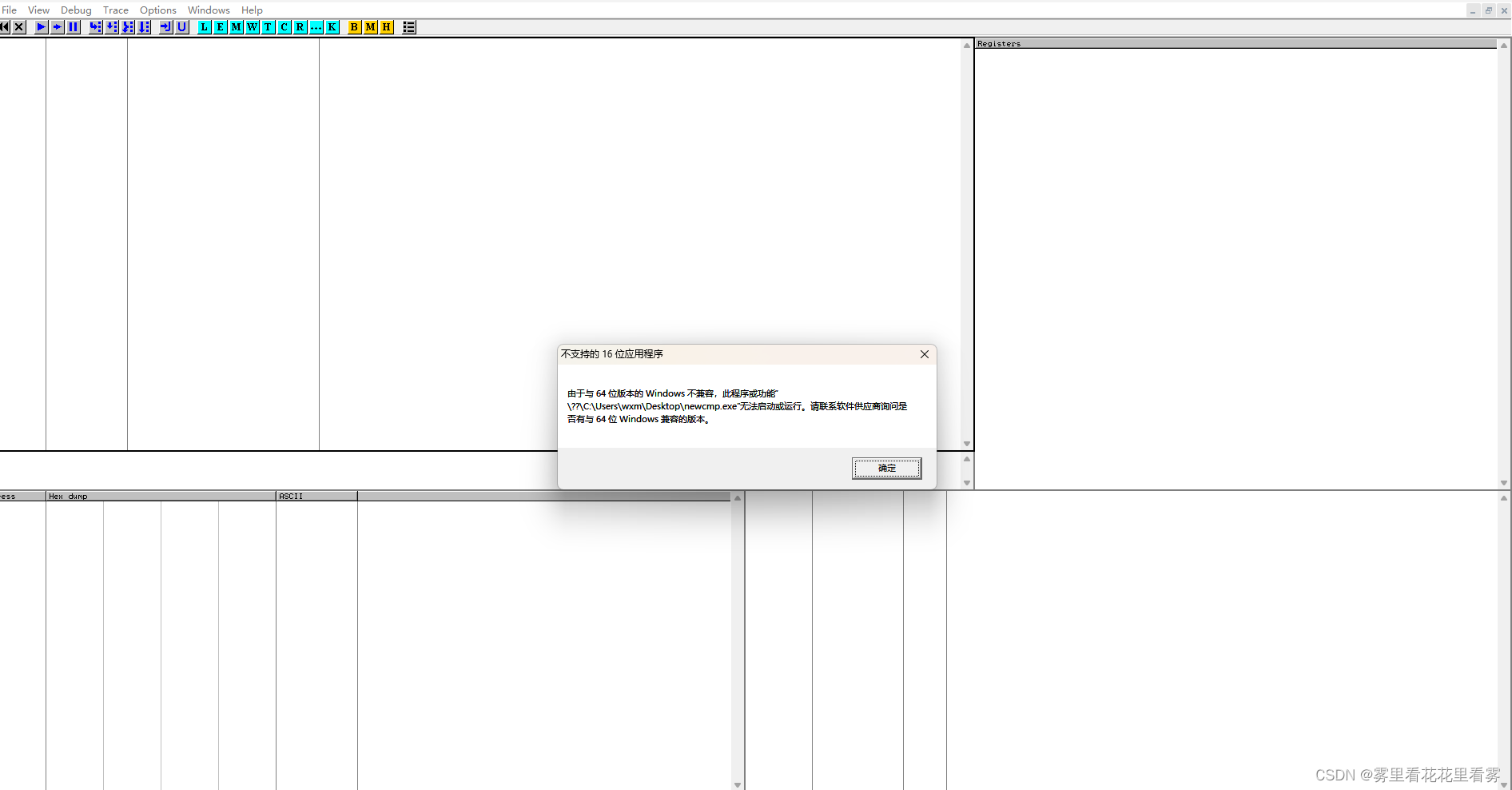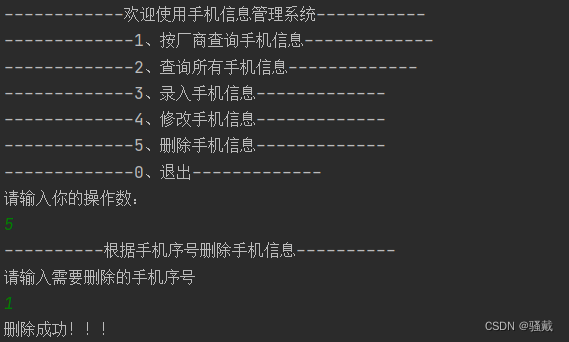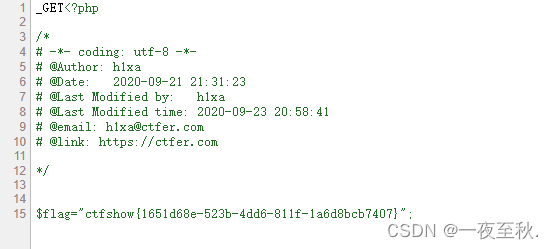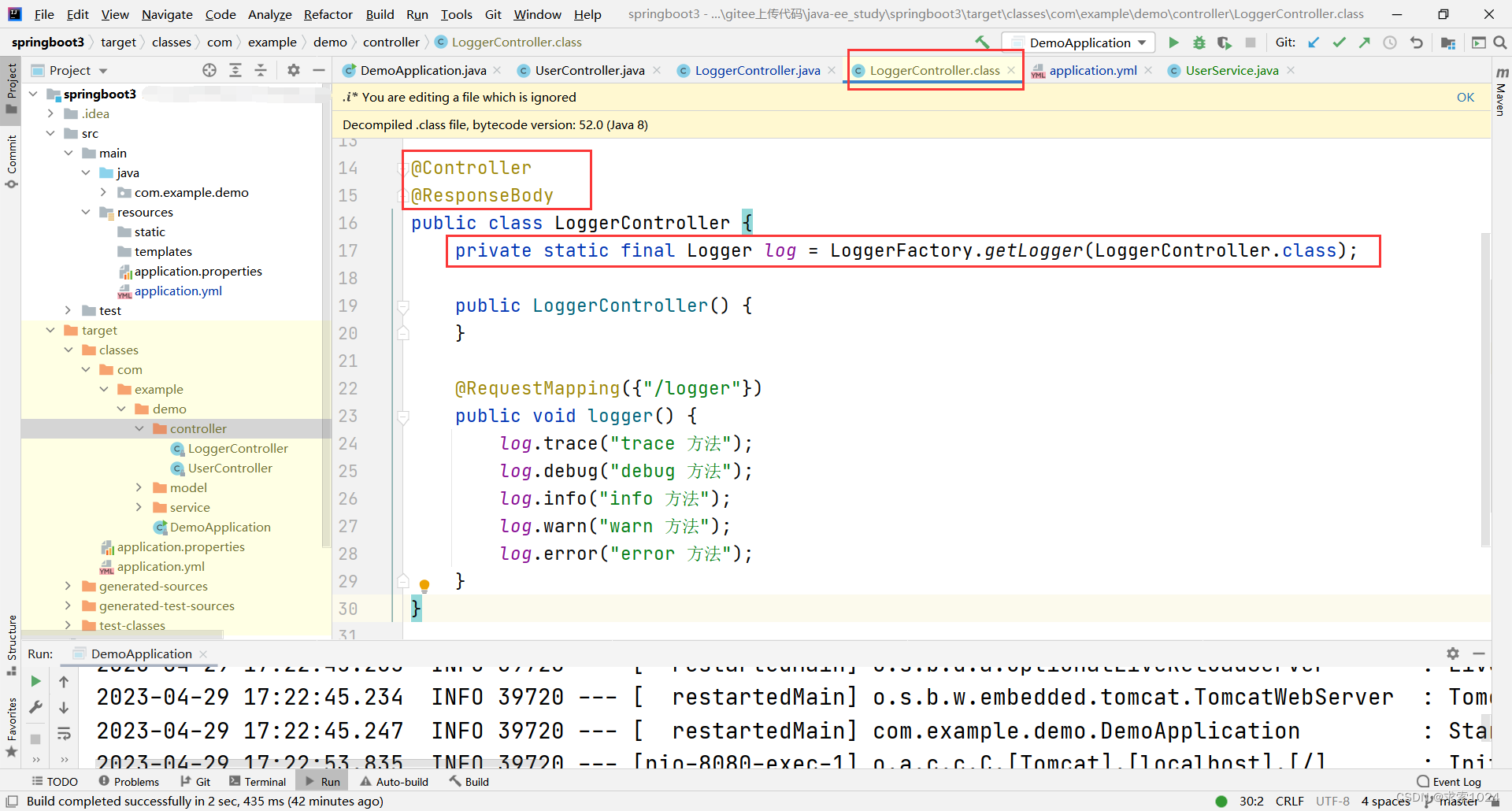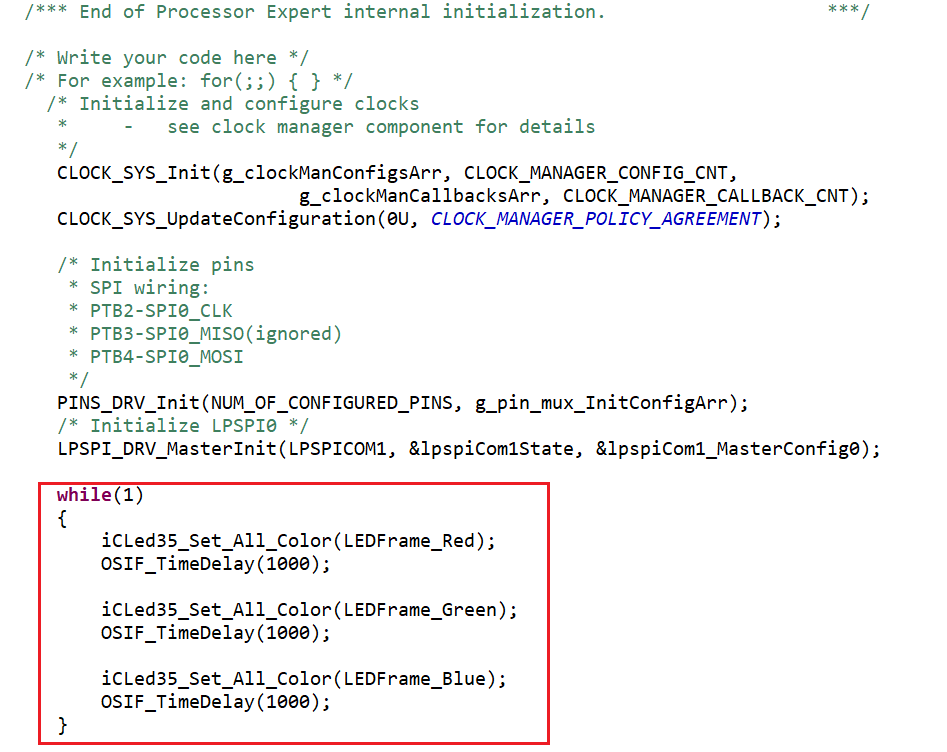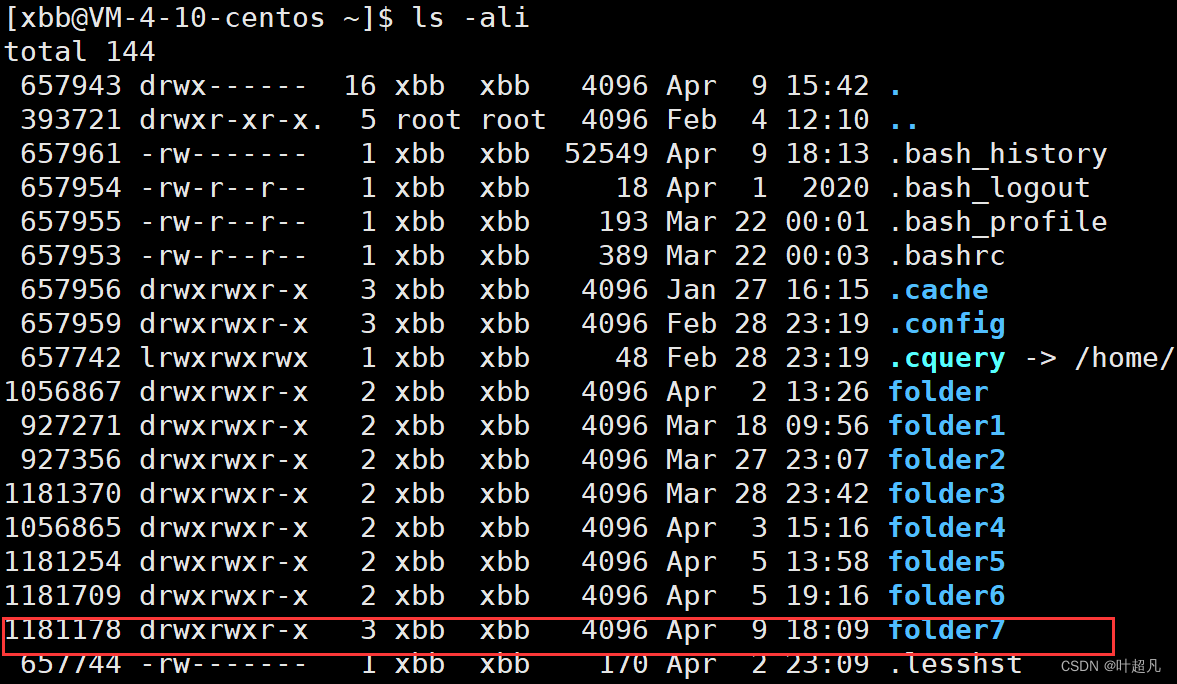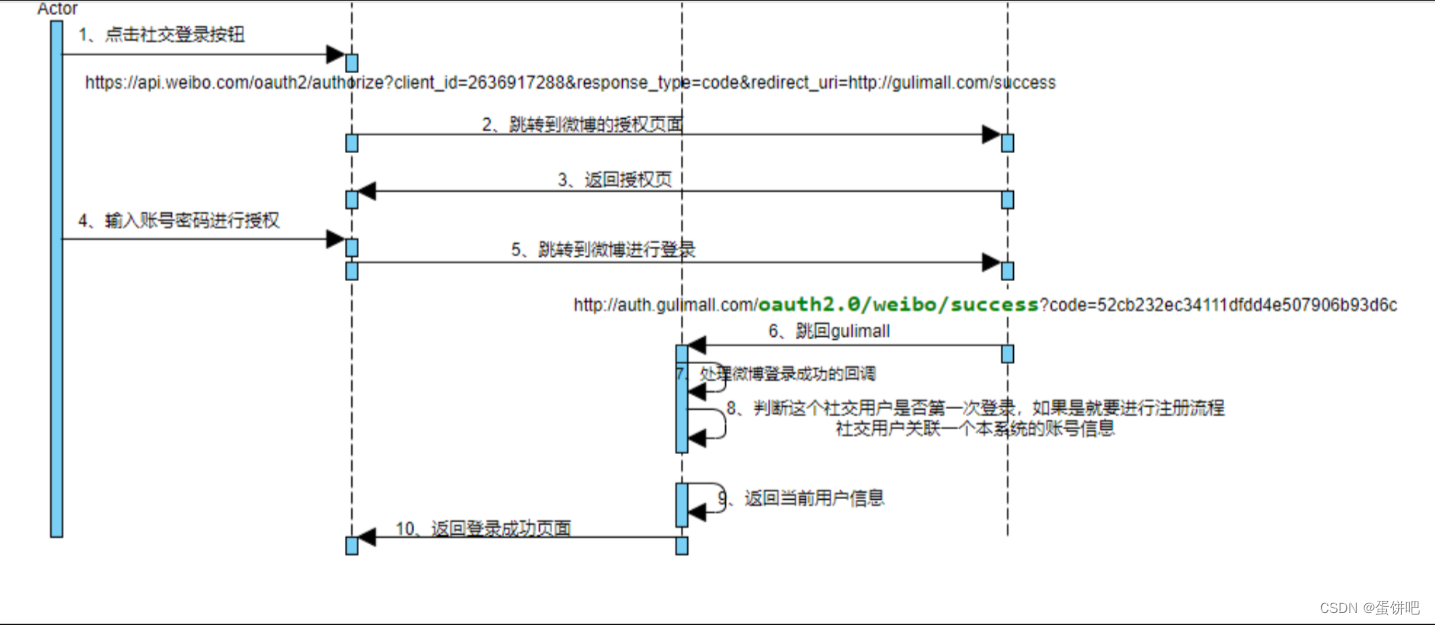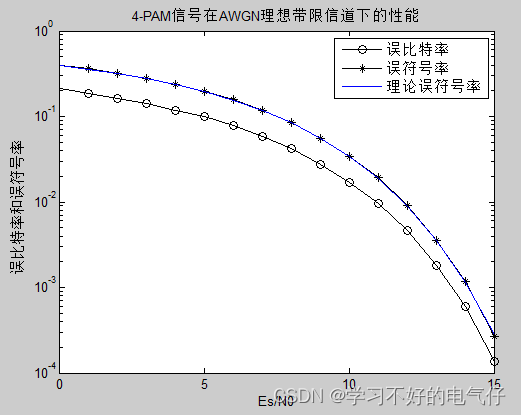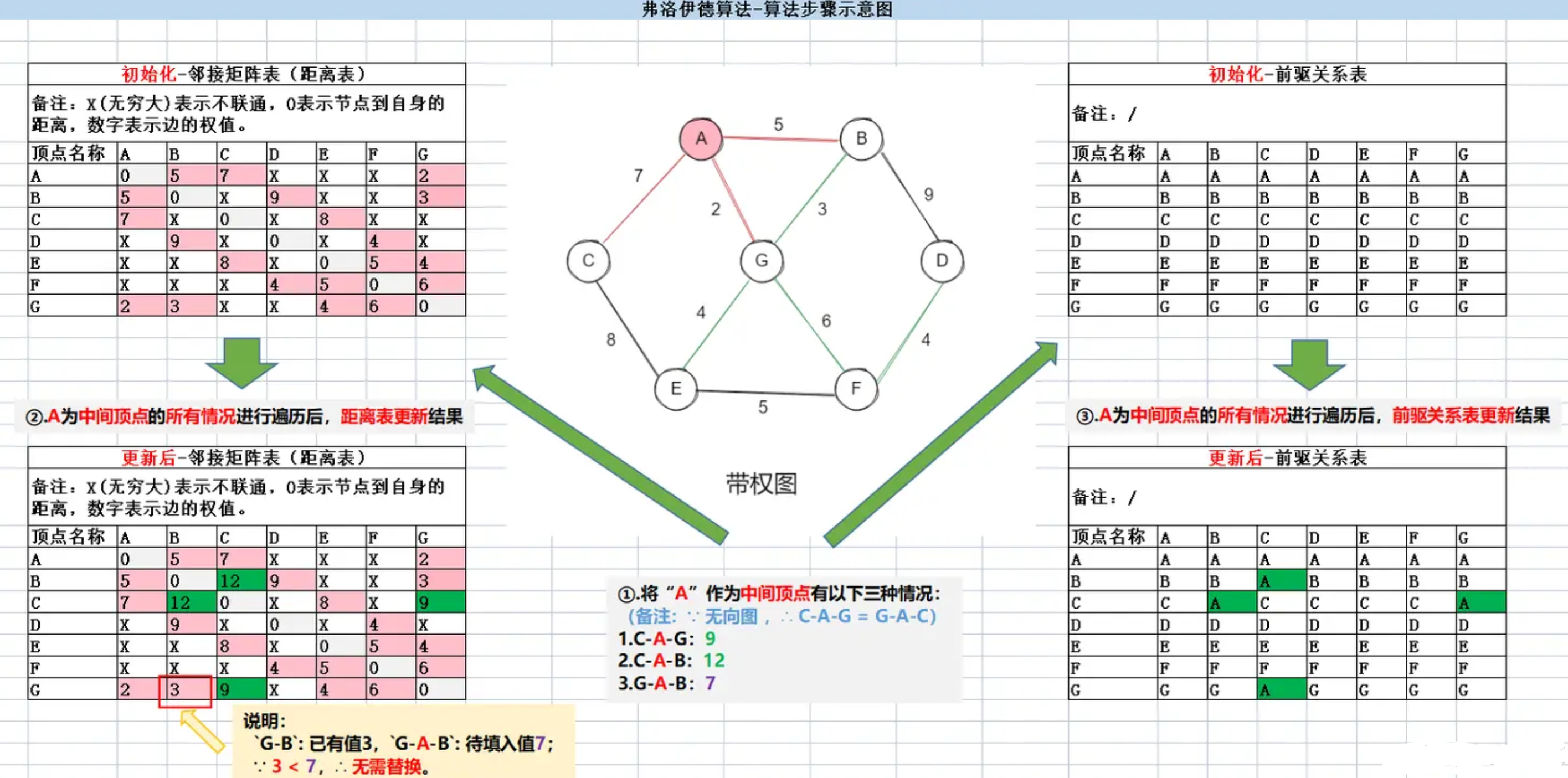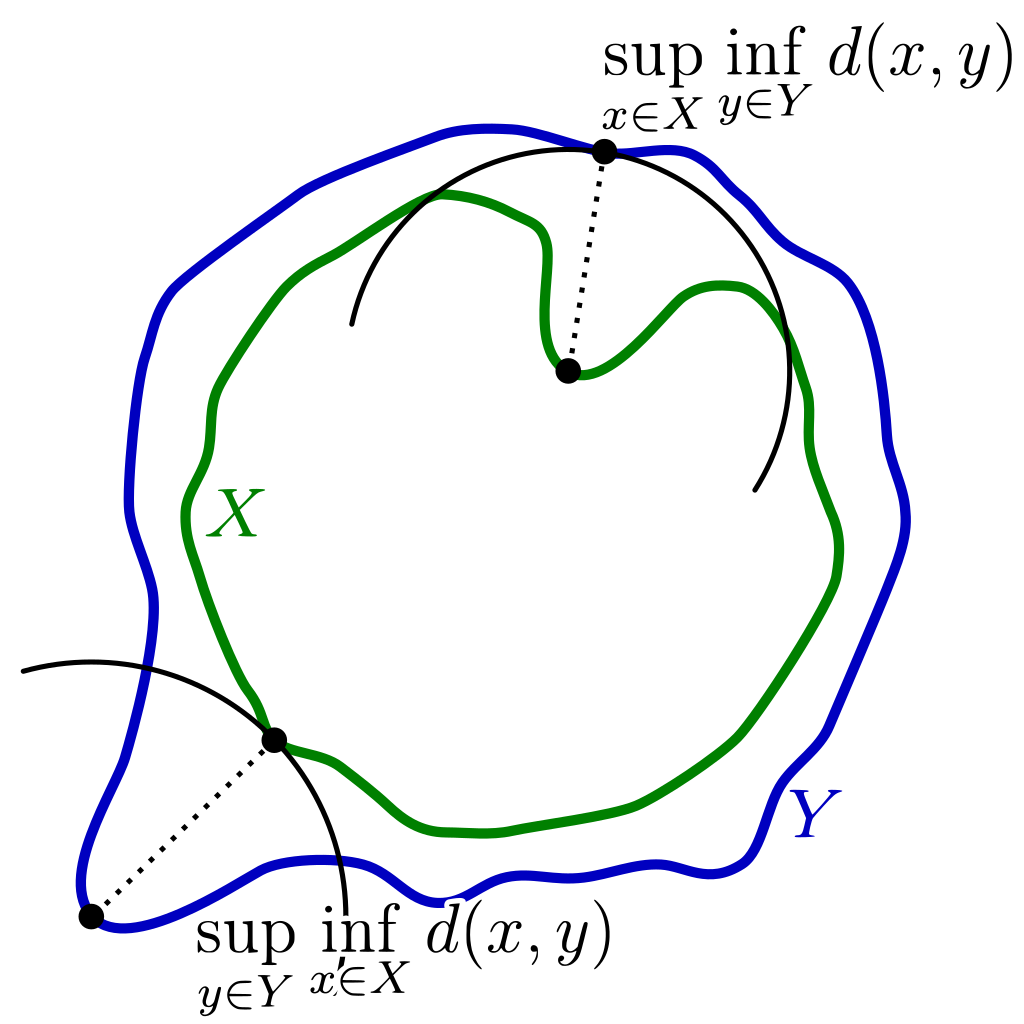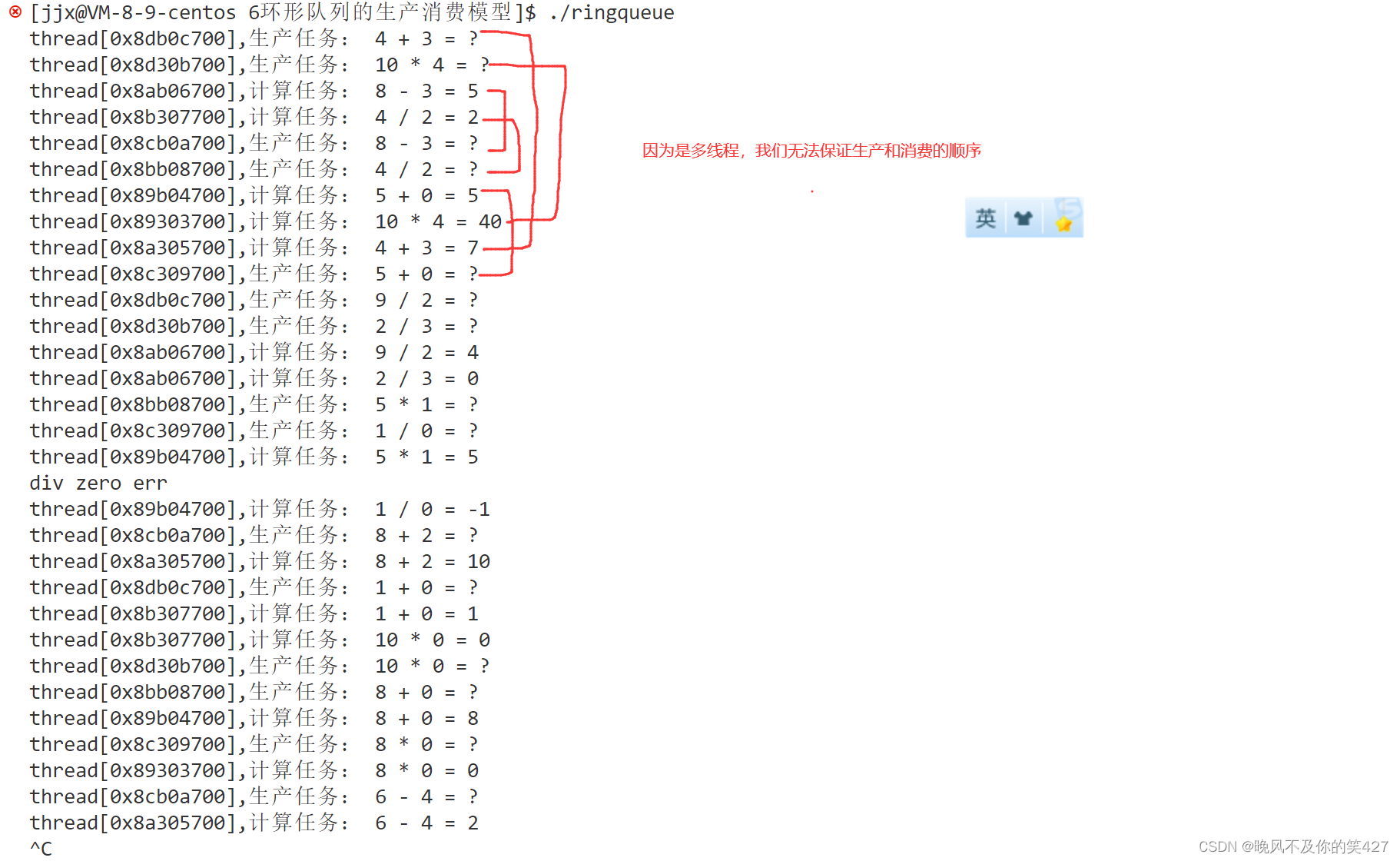Sentinel简介
Sentinel是阿里开源的一款面向分布式、多语言异构化服务架构的流量治理组件。
主要以流量为切入点,从流量路由、流量控制、流量整形、熔断降级、系统自适应过载保护、热点流量防护等多个维度来帮助开发者保障微服务的稳定性。
核心概念
资源
资源是Sentinel中一个非常重要的概念,资源就是Sentinel所保护的对象。
资源可以是一段代码,又或者是一个接口,Sentinel中并没有什么强制规定,但是实际项目中一般以一个接口为一个资源,比如说一个http接口,又或者是rpc接口,它们就是资源,可以被保护。
资源是通过Sentinel的API定义的,每个资源都有一个对应的名称,比如对于一个http接口资源来说,Sentinel默认的资源名称就是请求路径。
规则
规则也是一个重要的概念,规则其实比较好理解,比如说要对一个资源进行限流,那么限流的条件就是规则,后面在限流的时候会基于这个规则来判定是否需要限流。
Sentinel的规则分为流量控制规则、熔断降级规则以及系统保护规则,不同的规则实现的效果不一样。
快速入门
引入依赖
<dependency>
<groupId>com.alibaba.cloud</groupId>
<artifactId>spring-cloud-starter-alibaba-sentinel</artifactId>
<version>2021.1</version>
</dependency>
设置流控规则
@Configuration
public class FLowRulesConfig {
/**
* 定义限流规则
*/
@PostConstruct
public void initFLowRules() {
//1.创建限流规则
List<FlowRule> rules = new ArrayList<>();
FlowRule rule = new FlowRule();
// 定义资源,表示Sentinel会对哪个资源生效
rule.setResource("hello");
// 定义限流规则类型,QPS限流类型
rule.setGrade(RuleConstant.FLOW_GRADE_QPS);
// 定义QPS每秒能通过的请求个数
rule.setCount(2);
rules.add(rule);
// 2、加载限流规则
FlowRuleManager.loadRules(rules);
}
}
编写Controller,进行测试
@Slf4j
@RestController
public class HelloController {
@GetMapping("/hello")
public String startHello() {
// 进行限流
try (Entry entry = SphU.entry("hello")) { // 加载限流规则,若果存在才会往下执行
// 被保护的资源
return "hello Sentinel";
} catch (BlockException e) {
e.printStackTrace();
// 被限流或者被降级的操作
return "系统繁忙";
}
}
}
源码拆解
CtSph
核心是Entry entry = SphU.entry("hello")。
CtSph#entryWithPriority(),获取Context,如果不存在,则使用默认的。构造责任链,执行。
private Entry entryWithPriority(ResourceWrapper resourceWrapper, int count, boolean prioritized, Object... args)
throws BlockException {
Context context = ContextUtil.getContext();
if (context instanceof NullContext) {
// The {@link NullContext} indicates that the amount of context has exceeded the threshold,
// so here init the entry only. No rule checking will be done.
return new CtEntry(resourceWrapper, null, context);
}
if (context == null) {
// Using default context.
context = InternalContextUtil.internalEnter(Constants.CONTEXT_DEFAULT_NAME);
}
// Global switch is close, no rule checking will do.
if (!Constants.ON) {
return new CtEntry(resourceWrapper, null, context);
}
ProcessorSlot<Object> chain = lookProcessChain(resourceWrapper);
/*
* Means amount of resources (slot chain) exceeds {@link Constants.MAX_SLOT_CHAIN_SIZE},
* so no rule checking will be done.
*/
if (chain == null) {
return new CtEntry(resourceWrapper, null, context);
}
Entry e = new CtEntry(resourceWrapper, chain, context);
try {
chain.entry(context, resourceWrapper, null, count, prioritized, args);
} catch (BlockException e1) {
e.exit(count, args);
throw e1;
} catch (Throwable e1) {
// This should not happen, unless there are errors existing in Sentinel internal.
RecordLog.info("Sentinel unexpected exception", e1);
}
return e;
}
ProcessorSlot<Object> lookProcessChain(ResourceWrapper resourceWrapper) {
ProcessorSlotChain chain = chainMap.get(resourceWrapper);
if (chain == null) {
synchronized (LOCK) {
chain = chainMap.get(resourceWrapper);
if (chain == null) {
// Entry size limit.
if (chainMap.size() >= Constants.MAX_SLOT_CHAIN_SIZE) {
return null;
}
chain = SlotChainProvider.newSlotChain();
Map<ResourceWrapper, ProcessorSlotChain> newMap = new HashMap<ResourceWrapper, ProcessorSlotChain>(
chainMap.size() + 1);
newMap.putAll(chainMap);
newMap.put(resourceWrapper, chain);
chainMap = newMap;
}
}
}
return chain;
}
ContextUtil静态方法,会初始化一个默认的EntranceNode。
static {
// Cache the entrance node for default context.
initDefaultContext();
}
private static void initDefaultContext() {
String defaultContextName = Constants.CONTEXT_DEFAULT_NAME;
EntranceNode node = new EntranceNode(new StringResourceWrapper(defaultContextName, EntryType.IN), null);
Constants.ROOT.addChild(node);
contextNameNodeMap.put(defaultContextName, node);
}
ContextUtil
ContextUtil#enter(),当执行该方法的时候,会往线程变量ThreadLocal存入当前的Context
public static Context enter(String name, String origin) {
if (Constants.CONTEXT_DEFAULT_NAME.equals(name)) {
throw new ContextNameDefineException(
"The " + Constants.CONTEXT_DEFAULT_NAME + " can't be permit to defined!");
}
return trueEnter(name, origin);
}
protected static Context trueEnter(String name, String origin) {
Context context = contextHolder.get();
if (context == null) {
Map<String, DefaultNode> localCacheNameMap = contextNameNodeMap;
DefaultNode node = localCacheNameMap.get(name);
if (node == null) {
if (localCacheNameMap.size() > Constants.MAX_CONTEXT_NAME_SIZE) {
setNullContext();
return NULL_CONTEXT;
} else {
LOCK.lock();
try {
node = contextNameNodeMap.get(name);
if (node == null) {
if (contextNameNodeMap.size() > Constants.MAX_CONTEXT_NAME_SIZE) {
setNullContext();
return NULL_CONTEXT;
} else {
node = new EntranceNode(new StringResourceWrapper(name, EntryType.IN), null);
// Add entrance node.
Constants.ROOT.addChild(node);
Map<String, DefaultNode> newMap = new HashMap<>(contextNameNodeMap.size() + 1);
newMap.putAll(contextNameNodeMap);
newMap.put(name, node);
contextNameNodeMap = newMap;
}
}
} finally {
LOCK.unlock();
}
}
}
context = new Context(node, name);
context.setOrigin(origin);
contextHolder.set(context);
}
return context;
}
ProcessorSlotChain
SlotChainProvider#newSlotChain,按照默认的DefaultSlotChainBuilder生成责任链。
public static ProcessorSlotChain newSlotChain() {
if (slotChainBuilder != null) {
return slotChainBuilder.build();
}
// Resolve the slot chain builder SPI.
slotChainBuilder = SpiLoader.loadFirstInstanceOrDefault(SlotChainBuilder.class, DefaultSlotChainBuilder.class);
if (slotChainBuilder == null) {
// Should not go through here.
RecordLog.warn("[SlotChainProvider] Wrong state when resolving slot chain builder, using default");
slotChainBuilder = new DefaultSlotChainBuilder();
} else {
RecordLog.info("[SlotChainProvider] Global slot chain builder resolved: "
+ slotChainBuilder.getClass().getCanonicalName());
}
return slotChainBuilder.build();
}
DefaultSlotChainBuilder#build,根据spi加载ProcessorSlot。
public class DefaultSlotChainBuilder implements SlotChainBuilder {
@Override
public ProcessorSlotChain build() {
ProcessorSlotChain chain = new DefaultProcessorSlotChain();
// Note: the instances of ProcessorSlot should be different, since they are not stateless.
List<ProcessorSlot> sortedSlotList = SpiLoader.loadPrototypeInstanceListSorted(ProcessorSlot.class);
for (ProcessorSlot slot : sortedSlotList) {
if (!(slot instanceof AbstractLinkedProcessorSlot)) {
RecordLog.warn("The ProcessorSlot(" + slot.getClass().getCanonicalName() + ") is not an instance of AbstractLinkedProcessorSlot, can't be added into ProcessorSlotChain");
continue;
}
chain.addLast((AbstractLinkedProcessorSlot<?>) slot);
}
return chain;
}
}
NodeSelectorSlot
NodeSelectorSlot,处理同一个resource,使用同一个node
@SpiOrder(-10000)
public class NodeSelectorSlot extends AbstractLinkedProcessorSlot<Object> {
/**
* {@link DefaultNode}s of the same resource in different context.
*/
private volatile Map<String, DefaultNode> map = new HashMap<String, DefaultNode>(10);
@Override
public void entry(Context context, ResourceWrapper resourceWrapper, Object obj, int count, boolean prioritized, Object... args)
throws Throwable {
DefaultNode node = map.get(context.getName());
if (node == null) {
synchronized (this) {
node = map.get(context.getName());
if (node == null) {
node = new DefaultNode(resourceWrapper, null);
HashMap<String, DefaultNode> cacheMap = new HashMap<String, DefaultNode>(map.size());
cacheMap.putAll(map);
cacheMap.put(context.getName(), node);
map = cacheMap;
// Build invocation tree
((DefaultNode) context.getLastNode()).addChild(node);
}
}
}
context.setCurNode(node);
fireEntry(context, resourceWrapper, node, count, prioritized, args);
}
}
ClusterBuilderSlot
对于每一个 resource,会对应一个 ClusterNode 实例,如果不存在,就创建一个实例。当设置了 origin 的时候,会额外生成一个 StatisticsNode 实例,挂在 ClusterNode 上。
- 不同入口的访问数据是
DefaultNode - 统计所有入口访问数据之和是
ClusterNode - 来自某个服务的访问数据是
OriginNode
@SpiOrder(-9000)
public class ClusterBuilderSlot extends AbstractLinkedProcessorSlot<DefaultNode> {
private static volatile Map<ResourceWrapper, ClusterNode> clusterNodeMap = new HashMap<>();
private static final Object lock = new Object();
private volatile ClusterNode clusterNode = null;
@Override
public void entry(Context context, ResourceWrapper resourceWrapper, DefaultNode node, int count,
boolean prioritized, Object... args)
throws Throwable {
if (clusterNode == null) {
synchronized (lock) {
if (clusterNode == null) {
// Create the cluster node.
clusterNode = new ClusterNode(resourceWrapper.getName(), resourceWrapper.getResourceType());
HashMap<ResourceWrapper, ClusterNode> newMap = new HashMap<>(Math.max(clusterNodeMap.size(), 16));
newMap.putAll(clusterNodeMap);
newMap.put(node.getId(), clusterNode);
clusterNodeMap = newMap;
}
}
}
node.setClusterNode(clusterNode);
/*
* if context origin is set, we should get or create a new {@link Node} of
* the specific origin.
*/
if (!"".equals(context.getOrigin())) {
Node originNode = node.getClusterNode().getOrCreateOriginNode(context.getOrigin());
context.getCurEntry().setOriginNode(originNode);
}
fireEntry(context, resourceWrapper, node, count, prioritized, args);
}
}
LogSlot
对于下面的节点如果有抛出阻塞异常,进行捕捉,并且打印日志。记录哪些接口被规则挡住了。
@SpiOrder(-8000)
public class LogSlot extends AbstractLinkedProcessorSlot<DefaultNode> {
@Override
public void entry(Context context, ResourceWrapper resourceWrapper, DefaultNode obj, int count, boolean prioritized, Object... args)
throws Throwable {
try {
fireEntry(context, resourceWrapper, obj, count, prioritized, args);
} catch (BlockException e) {
EagleEyeLogUtil.log(resourceWrapper.getName(), e.getClass().getSimpleName(), e.getRuleLimitApp(),
context.getOrigin(), count);
throw e;
} catch (Throwable e) {
RecordLog.warn("Unexpected entry exception", e);
}
}
}
StatisticSlot
负责进行数据统计,为限流降级提供数据支持的。
@SpiOrder(-7000)
public class StatisticSlot extends AbstractLinkedProcessorSlot<DefaultNode> {
@Override
public void entry(Context context, ResourceWrapper resourceWrapper, DefaultNode node, int count,
boolean prioritized, Object... args) throws Throwable {
try {
// Do some checking.
fireEntry(context, resourceWrapper, node, count, prioritized, args);
// Request passed, add thread count and pass count.
node.increaseThreadNum();
node.addPassRequest(count);
if (context.getCurEntry().getOriginNode() != null) {
// Add count for origin node.
context.getCurEntry().getOriginNode().increaseThreadNum();
context.getCurEntry().getOriginNode().addPassRequest(count);
}
if (resourceWrapper.getEntryType() == EntryType.IN) {
// Add count for global inbound entry node for global statistics.
Constants.ENTRY_NODE.increaseThreadNum();
Constants.ENTRY_NODE.addPassRequest(count);
}
// Handle pass event with registered entry callback handlers.
for (ProcessorSlotEntryCallback<DefaultNode> handler : StatisticSlotCallbackRegistry.getEntryCallbacks()) {
handler.onPass(context, resourceWrapper, node, count, args);
}
} catch (PriorityWaitException ex) {
node.increaseThreadNum();
if (context.getCurEntry().getOriginNode() != null) {
// Add count for origin node.
context.getCurEntry().getOriginNode().increaseThreadNum();
}
if (resourceWrapper.getEntryType() == EntryType.IN) {
// Add count for global inbound entry node for global statistics.
Constants.ENTRY_NODE.increaseThreadNum();
}
// Handle pass event with registered entry callback handlers.
for (ProcessorSlotEntryCallback<DefaultNode> handler : StatisticSlotCallbackRegistry.getEntryCallbacks()) {
handler.onPass(context, resourceWrapper, node, count, args);
}
} catch (BlockException e) {
// Blocked, set block exception to current entry.
context.getCurEntry().setBlockError(e);
// Add block count.
node.increaseBlockQps(count);
if (context.getCurEntry().getOriginNode() != null) {
context.getCurEntry().getOriginNode().increaseBlockQps(count);
}
if (resourceWrapper.getEntryType() == EntryType.IN) {
// Add count for global inbound entry node for global statistics.
Constants.ENTRY_NODE.increaseBlockQps(count);
}
// Handle block event with registered entry callback handlers.
for (ProcessorSlotEntryCallback<DefaultNode> handler : StatisticSlotCallbackRegistry.getEntryCallbacks()) {
handler.onBlocked(e, context, resourceWrapper, node, count, args);
}
throw e;
} catch (Throwable e) {
// Unexpected internal error, set error to current entry.
context.getCurEntry().setError(e);
throw e;
}
}
}
AuthoritySlot
AuthoritySlot做权限控制,根据 origin 做黑白名单的控制:
@SpiOrder(-6000)
public class AuthoritySlot extends AbstractLinkedProcessorSlot<DefaultNode> {
@Override
public void entry(Context context, ResourceWrapper resourceWrapper, DefaultNode node, int count, boolean prioritized, Object... args)
throws Throwable {
checkBlackWhiteAuthority(resourceWrapper, context);
fireEntry(context, resourceWrapper, node, count, prioritized, args);
}
@Override
public void exit(Context context, ResourceWrapper resourceWrapper, int count, Object... args) {
fireExit(context, resourceWrapper, count, args);
}
void checkBlackWhiteAuthority(ResourceWrapper resource, Context context) throws AuthorityException {
Map<String, Set<AuthorityRule>> authorityRules = AuthorityRuleManager.getAuthorityRules();
if (authorityRules == null) {
return;
}
Set<AuthorityRule> rules = authorityRules.get(resource.getName());
if (rules == null) {
return;
}
for (AuthorityRule rule : rules) {
if (!AuthorityRuleChecker.passCheck(rule, context)) {
throw new AuthorityException(context.getOrigin(), rule);
}
}
}
}
AuthorityRuleChecker#passCheck
对origin进行规则校验
final class AuthorityRuleChecker {
static boolean passCheck(AuthorityRule rule, Context context) {
String requester = context.getOrigin();
// Empty origin or empty limitApp will pass.
if (StringUtil.isEmpty(requester) || StringUtil.isEmpty(rule.getLimitApp())) {
return true;
}
// Do exact match with origin name.
int pos = rule.getLimitApp().indexOf(requester);
boolean contain = pos > -1;
if (contain) {
boolean exactlyMatch = false;
String[] appArray = rule.getLimitApp().split(",");
for (String app : appArray) {
if (requester.equals(app)) {
exactlyMatch = true;
break;
}
}
contain = exactlyMatch;
}
int strategy = rule.getStrategy();
if (strategy == RuleConstant.AUTHORITY_BLACK && contain) {
return false;
}
if (strategy == RuleConstant.AUTHORITY_WHITE && !contain) {
return false;
}
return true;
}
private AuthorityRuleChecker() {}
}
SystemSlot
根据整个系统运行的统计数据来限流的,防止当前系统负载过高。它支持入口qps、线程数、响应时间、cpu使用率、负载5个限流的维度。
@SpiOrder(-5000)
public class SystemSlot extends AbstractLinkedProcessorSlot<DefaultNode> {
@Override
public void entry(Context context, ResourceWrapper resourceWrapper, DefaultNode node, int count,
boolean prioritized, Object... args) throws Throwable {
SystemRuleManager.checkSystem(resourceWrapper);
fireEntry(context, resourceWrapper, node, count, prioritized, args);
}
@Override
public void exit(Context context, ResourceWrapper resourceWrapper, int count, Object... args) {
fireExit(context, resourceWrapper, count, args);
}
}
Sentinel 针对所有的入口流量,使用了一个全局的 ENTRY_NODE 进行统计,所以我们也要知道,系统保护规则是全局的,和具体的某个资源没有关系。
public static void checkSystem(ResourceWrapper resourceWrapper) throws BlockException {
if (resourceWrapper == null) {
return;
}
// Ensure the checking switch is on.
if (!checkSystemStatus.get()) {
return;
}
// for inbound traffic only
if (resourceWrapper.getEntryType() != EntryType.IN) {
return;
}
// total qps
double currentQps = Constants.ENTRY_NODE == null ? 0.0 : Constants.ENTRY_NODE.successQps();
if (currentQps > qps) {
throw new SystemBlockException(resourceWrapper.getName(), "qps");
}
// total thread
int currentThread = Constants.ENTRY_NODE == null ? 0 : Constants.ENTRY_NODE.curThreadNum();
if (currentThread > maxThread) {
throw new SystemBlockException(resourceWrapper.getName(), "thread");
}
double rt = Constants.ENTRY_NODE == null ? 0 : Constants.ENTRY_NODE.avgRt();
if (rt > maxRt) {
throw new SystemBlockException(resourceWrapper.getName(), "rt");
}
// load. BBR algorithm.
if (highestSystemLoadIsSet && getCurrentSystemAvgLoad() > highestSystemLoad) {
if (!checkBbr(currentThread)) {
throw new SystemBlockException(resourceWrapper.getName(), "load");
}
}
// cpu usage
if (highestCpuUsageIsSet && getCurrentCpuUsage() > highestCpuUsage) {
throw new SystemBlockException(resourceWrapper.getName(), "cpu");
}
}
FlowSlot
流控的核心处理类
@SpiOrder(-2000)
public class FlowSlot extends AbstractLinkedProcessorSlot<DefaultNode> {
private final FlowRuleChecker checker;
public FlowSlot() {
this(new FlowRuleChecker());
}
/**
* Package-private for test.
*
* @param checker flow rule checker
* @since 1.6.1
*/
FlowSlot(FlowRuleChecker checker) {
AssertUtil.notNull(checker, "flow checker should not be null");
this.checker = checker;
}
@Override
public void entry(Context context, ResourceWrapper resourceWrapper, DefaultNode node, int count,
boolean prioritized, Object... args) throws Throwable {
checkFlow(resourceWrapper, context, node, count, prioritized);
fireEntry(context, resourceWrapper, node, count, prioritized, args);
}
void checkFlow(ResourceWrapper resource, Context context, DefaultNode node, int count, boolean prioritized)
throws BlockException {
checker.checkFlow(ruleProvider, resource, context, node, count, prioritized);
}
}
FlowRuleChecker#checkFlow
public class FlowRuleChecker {
public void checkFlow(Function<String, Collection<FlowRule>> ruleProvider, ResourceWrapper resource,
Context context, DefaultNode node, int count, boolean prioritized) throws BlockException {
if (ruleProvider == null || resource == null) {
return;
}
Collection<FlowRule> rules = ruleProvider.apply(resource.getName());
if (rules != null) {
for (FlowRule rule : rules) {
if (!canPassCheck(rule, context, node, count, prioritized)) {
throw new FlowException(rule.getLimitApp(), rule);
}
}
}
}
private static boolean passLocalCheck(FlowRule rule, Context context, DefaultNode node, int acquireCount,
boolean prioritized) {
Node selectedNode = selectNodeByRequesterAndStrategy(rule, context, node);
if (selectedNode == null) {
return true;
}
return rule.getRater().canPass(selectedNode, acquireCount, prioritized);
}
}
DegradeSlot
降级策略。Sentinel支持三种熔断策略:慢调用比例、异常比例 、异常数。
Sentinel会为每个设置的规则都创建一个熔断器,熔断器有三种状态,OPEN(打开)、HALF_OPEN(半开)、CLOSED(关闭)
- 当处于CLOSED状态时,可以访问资源,访问之后会进行慢调用比例、异常比例、异常数的统计,一旦达到了设置的阈值,就会将熔断器的状态设置为OPEN
- 当处于OPEN状态时,会去判断是否达到了熔断时间,如果没到,拒绝访问,如果到了,那么就将状态改成HALF_OPEN,然后访问资源,访问之后会对访问结果进行判断,符合规则设置的要求,直接将熔断器设置为CLOSED,关闭熔断器,不符合则还是改为OPEN状态
- 当处于HALF_OPEN状态时,直接拒绝访问资源
@SpiOrder(-1000)
public class DegradeSlot extends AbstractLinkedProcessorSlot<DefaultNode> {
@Override
public void entry(Context context, ResourceWrapper resourceWrapper, DefaultNode node, int count,
boolean prioritized, Object... args) throws Throwable {
performChecking(context, resourceWrapper);
fireEntry(context, resourceWrapper, node, count, prioritized, args);
}
void performChecking(Context context, ResourceWrapper r) throws BlockException {
List<CircuitBreaker> circuitBreakers = DegradeRuleManager.getCircuitBreakers(r.getName());
if (circuitBreakers == null || circuitBreakers.isEmpty()) {
return;
}
for (CircuitBreaker cb : circuitBreakers) {
if (!cb.tryPass(context)) {
throw new DegradeException(cb.getRule().getLimitApp(), cb.getRule());
}
}
}
}
SentinelWebInterceptor
SentinelWebInterceptor继承AbstractSentinelInterceptor,当有请求访问,会执行AbstractSentinelInterceptor#preHandle。
public boolean preHandle(HttpServletRequest request, HttpServletResponse response, Object handler) throws Exception {
try {
String resourceName = this.getResourceName(request);
if (StringUtil.isEmpty(resourceName)) {
return true;
} else if (this.increaseReferece(request, this.baseWebMvcConfig.getRequestRefName(), 1) != 1) {
return true;
} else {
String origin = this.parseOrigin(request);
String contextName = this.getContextName(request);
ContextUtil.enter(contextName, origin);
Entry entry = SphU.entry(resourceName, 1, EntryType.IN);
request.setAttribute(this.baseWebMvcConfig.getRequestAttributeName(), entry);
return true;
}
} catch (BlockException var12) {
BlockException e = var12;
try {
this.handleBlockException(request, response, e);
} finally {
ContextUtil.exit();
}
return false;
}
}
InitFunc
SphU#entry(),执行该方法会调用Env的静态变量,Env进行初始化。
public static Entry entry(String name) throws BlockException {
return Env.sph.entry(name, EntryType.OUT, 1, OBJECTS0);
}
Env执行静态方法。
public class Env {
public static final Sph sph = new CtSph();
static {
// If init fails, the process will exit.
InitExecutor.doInit();
}
}
InitExecutor#doInit
使用 SPI 加载 InitFunc 的实现
public static void doInit() {
if (!initialized.compareAndSet(false, true)) {
return;
}
try {
ServiceLoader<InitFunc> loader = ServiceLoaderUtil.getServiceLoader(InitFunc.class);
List<OrderWrapper> initList = new ArrayList<OrderWrapper>();
for (InitFunc initFunc : loader) {
RecordLog.info("[InitExecutor] Found init func: " + initFunc.getClass().getCanonicalName());
insertSorted(initList, initFunc);
}
for (OrderWrapper w : initList) {
w.func.init();
RecordLog.info(String.format("[InitExecutor] Executing %s with order %d",
w.func.getClass().getCanonicalName(), w.order));
}
} catch (Exception ex) {
RecordLog.warn("[InitExecutor] WARN: Initialization failed", ex);
ex.printStackTrace();
} catch (Error error) {
RecordLog.warn("[InitExecutor] ERROR: Initialization failed with fatal error", error);
error.printStackTrace();
}
}
HeartbeatSenderInitFunc,使用HeartbeatSenderProvider获取加载HeartbeatSender,定时执行。
@InitOrder(-1)
public class HeartbeatSenderInitFunc implements InitFunc {
private ScheduledExecutorService pool = null;
public HeartbeatSenderInitFunc() {
}
private void initSchedulerIfNeeded() {
if (this.pool == null) {
this.pool = new ScheduledThreadPoolExecutor(2, new NamedThreadFactory("sentinel-heartbeat-send-task", true), new DiscardOldestPolicy());
}
}
public void init() {
HeartbeatSender sender = HeartbeatSenderProvider.getHeartbeatSender();
if (sender == null) {
RecordLog.warn("[HeartbeatSenderInitFunc] WARN: No HeartbeatSender loaded", new Object[0]);
} else {
this.initSchedulerIfNeeded();
long interval = this.retrieveInterval(sender);
this.setIntervalIfNotExists(interval);
this.scheduleHeartbeatTask(sender, interval);
}
}
private boolean isValidHeartbeatInterval(Long interval) {
return interval != null && interval > 0L;
}
private void setIntervalIfNotExists(long interval) {
SentinelConfig.setConfig("csp.sentinel.heartbeat.interval.ms", String.valueOf(interval));
}
long retrieveInterval(HeartbeatSender sender) {
Long intervalInConfig = TransportConfig.getHeartbeatIntervalMs();
if (this.isValidHeartbeatInterval(intervalInConfig)) {
RecordLog.info("[HeartbeatSenderInitFunc] Using heartbeat interval in Sentinel config property: " + intervalInConfig, new Object[0]);
return intervalInConfig;
} else {
long senderInterval = sender.intervalMs();
RecordLog.info("[HeartbeatSenderInit] Heartbeat interval not configured in config property or invalid, using sender default: " + senderInterval, new Object[0]);
return senderInterval;
}
}
private void scheduleHeartbeatTask(final HeartbeatSender sender, long interval) {
this.pool.scheduleAtFixedRate(new Runnable() {
public void run() {
try {
sender.sendHeartbeat();
} catch (Throwable var2) {
RecordLog.warn("[HeartbeatSender] Send heartbeat error", var2);
}
}
}, 5000L, interval, TimeUnit.MILLISECONDS);
RecordLog.info("[HeartbeatSenderInit] HeartbeatSender started: " + sender.getClass().getCanonicalName(), new Object[0]);
}
}
HeartbeatSenderProvider静态方法块进行初始化,根据SPI获取HeartbeatSender。
public final class HeartbeatSenderProvider {
private static HeartbeatSender heartbeatSender = null;
private static void resolveInstance() {
HeartbeatSender resolved = (HeartbeatSender)SpiLoader.loadHighestPriorityInstance(HeartbeatSender.class);
if (resolved == null) {
RecordLog.warn("[HeartbeatSenderProvider] WARN: No existing HeartbeatSender found", new Object[0]);
} else {
heartbeatSender = resolved;
RecordLog.info("[HeartbeatSenderProvider] HeartbeatSender activated: " + resolved.getClass().getCanonicalName(), new Object[0]);
}
}
public static HeartbeatSender getHeartbeatSender() {
return heartbeatSender;
}
private HeartbeatSenderProvider() {
}
static {
resolveInstance();
}
}
StatisticNode
ClusterNode,DefaultNode,EntranceNode都继承StatisticNode。
StatisticNode#addPassRequest,增加通过的请求数。
private transient volatile Metric rollingCounterInSecond = new ArrayMetric(SampleCountProperty.SAMPLE_COUNT,
IntervalProperty.INTERVAL);
private transient Metric rollingCounterInMinute = new ArrayMetric(60, 60 * 1000, false);
@Override
public void addPassRequest(int count) {
rollingCounterInSecond.addPass(count);
rollingCounterInMinute.addPass(count);
}
ArrayMetric的data属性默认实现OccupiableBucketLeapArray
private final LeapArray<MetricBucket> data;
public ArrayMetric(int sampleCount, int intervalInMs) {
this.data = new OccupiableBucketLeapArray(sampleCount, intervalInMs);
}
LeapArray#currentWindow(long)。添加数据的时候,我们要先获取操作的目标窗口,也就是 currentWindow 这个方法。
public WindowWrap<T> currentWindow(long timeMillis) {
if (timeMillis < 0) {
return null;
}
int idx = calculateTimeIdx(timeMillis);
// Calculate current bucket start time.
long windowStart = calculateWindowStart(timeMillis);
/*
* Get bucket item at given time from the array.
*
* (1) Bucket is absent, then just create a new bucket and CAS update to circular array.
* (2) Bucket is up-to-date, then just return the bucket.
* (3) Bucket is deprecated, then reset current bucket and clean all deprecated buckets.
*/
while (true) {
WindowWrap<T> old = array.get(idx);
if (old == null) {
WindowWrap<T> window = new WindowWrap<T>(windowLengthInMs, windowStart, newEmptyBucket(timeMillis));
if (array.compareAndSet(idx, null, window)) {
// Successfully updated, return the created bucket.
return window;
} else {
// Contention failed, the thread will yield its time slice to wait for bucket available.
Thread.yield();
}
} else if (windowStart == old.windowStart()) {
return old;
} else if (windowStart > old.windowStart()) {
if (updateLock.tryLock()) {
try {
// Successfully get the update lock, now we reset the bucket.
return resetWindowTo(old, windowStart);
} finally {
updateLock.unlock();
}
} else {
// Contention failed, the thread will yield its time slice to wait for bucket available.
Thread.yield();
}
} else if (windowStart < old.windowStart()) {
// Should not go through here, as the provided time is already behind.
return new WindowWrap<T>(windowLengthInMs, windowStart, newEmptyBucket(timeMillis));
}
}
}
LeapArray#values(long),获取有效的窗口中的数据。
public List<T> values(long timeMillis) {
if (timeMillis < 0) {
return new ArrayList<T>();
}
int size = array.length();
List<T> result = new ArrayList<T>(size);
for (int i = 0; i < size; i++) {
WindowWrap<T> windowWrap = array.get(i);
if (windowWrap == null || isWindowDeprecated(timeMillis, windowWrap)) {
continue;
}
result.add(windowWrap.value());
}
return result;
}
TrafficShapingController
FlowRuleUtil#generateRater,根据规则生成对应的TrafficShapingController
private static TrafficShapingController generateRater(/*@Valid*/ FlowRule rule) {
if (rule.getGrade() == RuleConstant.FLOW_GRADE_QPS) {
switch (rule.getControlBehavior()) {
case RuleConstant.CONTROL_BEHAVIOR_WARM_UP:
return new WarmUpController(rule.getCount(), rule.getWarmUpPeriodSec(),
ColdFactorProperty.coldFactor);
case RuleConstant.CONTROL_BEHAVIOR_RATE_LIMITER:
return new RateLimiterController(rule.getMaxQueueingTimeMs(), rule.getCount());
case RuleConstant.CONTROL_BEHAVIOR_WARM_UP_RATE_LIMITER:
return new WarmUpRateLimiterController(rule.getCount(), rule.getWarmUpPeriodSec(),
rule.getMaxQueueingTimeMs(), ColdFactorProperty.coldFactor);
case RuleConstant.CONTROL_BEHAVIOR_DEFAULT:
default:
// Default mode or unknown mode: default traffic shaping controller (fast-reject).
}
}
return new DefaultController(rule.getCount(), rule.getGrade());
}
DefaultController#canPass(),超过流量阈值的会直接拒绝。
@Override
public boolean canPass(Node node, int acquireCount, boolean prioritized) {
int curCount = avgUsedTokens(node);
if (curCount + acquireCount > count) {
if (prioritized && grade == RuleConstant.FLOW_GRADE_QPS) {
long currentTime;
long waitInMs;
currentTime = TimeUtil.currentTimeMillis();
waitInMs = node.tryOccupyNext(currentTime, acquireCount, count);
if (waitInMs < OccupyTimeoutProperty.getOccupyTimeout()) {
node.addWaitingRequest(currentTime + waitInMs, acquireCount);
node.addOccupiedPass(acquireCount);
sleep(waitInMs);
// PriorityWaitException indicates that the request will pass after waiting for {@link @waitInMs}.
throw new PriorityWaitException(waitInMs);
}
}
return false;
}
return true;
}
SentinelResourceAspect
@Aspect
public class SentinelResourceAspect extends AbstractSentinelAspectSupport {
@Pointcut("@annotation(com.alibaba.csp.sentinel.annotation.SentinelResource)")
public void sentinelResourceAnnotationPointcut() {
}
@Around("sentinelResourceAnnotationPointcut()")
public Object invokeResourceWithSentinel(ProceedingJoinPoint pjp) throws Throwable {
Method originMethod = resolveMethod(pjp);
SentinelResource annotation = originMethod.getAnnotation(SentinelResource.class);
if (annotation == null) {
// Should not go through here.
throw new IllegalStateException("Wrong state for SentinelResource annotation");
}
String resourceName = getResourceName(annotation.value(), originMethod);
EntryType entryType = annotation.entryType();
int resourceType = annotation.resourceType();
Entry entry = null;
try {
entry = SphU.entry(resourceName, resourceType, entryType, pjp.getArgs());
Object result = pjp.proceed();
return result;
} catch (BlockException ex) {
return handleBlockException(pjp, annotation, ex);
} catch (Throwable ex) {
Class<? extends Throwable>[] exceptionsToIgnore = annotation.exceptionsToIgnore();
// The ignore list will be checked first.
if (exceptionsToIgnore.length > 0 && exceptionBelongsTo(ex, exceptionsToIgnore)) {
throw ex;
}
if (exceptionBelongsTo(ex, annotation.exceptionsToTrace())) {
traceException(ex);
return handleFallback(pjp, annotation, ex);
}
// No fallback function can handle the exception, so throw it out.
throw ex;
} finally {
if (entry != null) {
entry.exit(1, pjp.getArgs());
}
}
}
}


